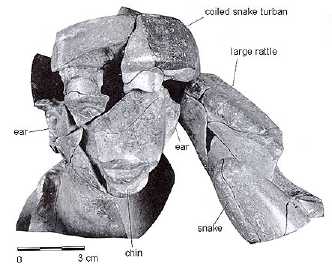
Front view of the West figurine with rattlesnake headdress, Sponemann site.
|
Snakes, another ubiquitous inhabitant of wetlands and swamps, are also represented in Mississippian art. Typically, the detail is such that the species of snake can not be determined, and likely was not meant to be represented. Rather, a generalized legless serpent body is portrayed with body parts of other animals, notably the head of a panther. The panther, or more accurately parts of the panther, are another important natural icon in Mississippian art. Historically, this species (Felis concolor) is cosmopolitan in its distribution, surviving well in habitats where its main food source, deer, is abundant. Wetlands and swamps are one preferred panther habitat, however, possibly because of the dense vegetation found here (ENV). Also, it is worth noting that although panthers have an aversion to water, they are particularly good swimmers.
|
Characteristics of snakes related to their natural habitat, behavior or perhaps their role in a particular myth or myths are being conveyed. Whether or not there is any specific message beyond their association with wetlands is unknown. They clearly constitute part of a mythical or supernatural being.